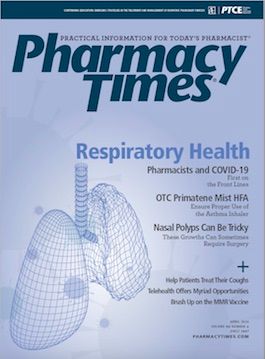Publication
Article
Pharmacy Times
Talicia From RedHill Biopharma Ltd
Author(s):
The fda has approved talicia (amoxicillin, omeprazole magnesium, and rifabutin) for the treatment of Helicobacter pylori infection in adults.
The fda has approved talicia (amoxicillin, omeprazole magnesium, and rifabutin) for the treatment of Helicobacter pylori infection in adults.1
H pylori bacterial infection affects more than 50% of the global population and about 35% of Americans. It is classified as a group I carcinogen and is the strongest risk factor for the development of gastric cancer. It is also a major risk factor for gastric mucosa-associated lymphoid tissue lymphoma and peptic ulcer disease. Because of the growing resistance of H pylori to clarithromycin and metronidazole, treatment failure occurs in 25% to 40% of patients who receive standard-of-care therapies.2
PHARMACOLOGY AND PHARMACOKINETICS
Amoxicillin is a penicillin-class antibacterial agent that inhibits cell wall biosynthesis to cause the death of bacteria. Omeprazole is a proton pump inhibitor. Rifabutin is a rifamycin antibacterial agent that inhibits DNA-dependent RNA polymerase in susceptible microorganisms. Omeprazole is a timedependent inhibitor of cytochrome P450 (CYP) 2C19 and can increase the exposure of CYP2C19 substrates.
DOSAGE AND ADMINISTRATION
The dosage of Talicia is 4 capsules every 8 hours for 14 days with food. Patients should swallow the medication whole with 8 oz of water. Patients using Talicia should avoid alcohol during treatment. Each delayed-release capsule contains 250 mg of amoxicillin, 10 mg of omeprazole (equivalent to 10.3 mg of omeprazole magnesium), and 12.5 mg of rifabutin.1
CLINICAL TRIALS
Investigators studied the effectiveness and safety of Talicia in a controlled, double-blind, randomized trial of treatment-naïve adults with H pylori infection. The trial was designed to evaluate the added contribution of rifabutin as a component of triple-therapy treatment. Participants received either Talicia or a total daily dose of amoxicillin 3000 mg and omeprazole 120 mg for 14 consecutive days. The Talicia group demonstrated an eradication rate of 83.8% compared with 57.7% for the amoxicillin and omeprazole group, with no reports of rifabutin resistance.
A double-blind, placebo-controlled, randomized trial provided supportive evidence for the efficacy of Talicia. It compared Talicia with a placebo in adults with H pylori infection who reported epigastric discomfort or pain. The study results showed an eradication rate of 76.6% for the group using Talicia compared with 2.4% for the placebo group.1,2
CONTRAINDICATIONS, WARNINGS, AND PRECAUTIONS
The use of Talicia is contraindicated in patients with a known hypersensitivity to any component of the medication, including amoxicillin, β-lactam antibacterial agents, omeprazole, rifabutin, and rifamycin. It is also contraindicated in patients using delavirdine, rilpivirine-containing products, or voriconazole.
Serious and occasionally fatal hypersensitivity reactions have been reported during treatment with components of Talicia. Clostridioides difficile—associated diarrhea has been reported with the use of the components of Talicia. Because Talicia may reduce the efficacy of hormonal contraceptives, patients should use an additional highly effective nonhormonal method of contraception during treatment. If acute interstitial nephritis occurs, patients should discontinue treatment with Talicia. Cutaneous lupus erythematosus and systemic lupus erythematosus have occurred during treatment with omeprazole, both as exacerbation of an existing condition and new onset. If signs or symptoms develop, patients should discontinue treatment with Talicia. To reduce the development of drug-resistant bacteria and maintain the effectiveness of Talicia and other antibacterial medications, providers should use Talicia only for infections that are proved or strongly suspected to be caused by bacteria. Patients should not use Talicia during pregnancy. Those with hepatic or severe renal impairment should avoid its use.
Talicia should not be used with other CYP2C19 or CYP3A4 inducers or inhibitors. Providers should exercise caution during concomitant use of Talicia with protease inhibitors, as some may require a dose adjustment, and certain protease inhibitors, such as amprenavir and indinavir, should not be used with Talicia. Patients taking high-dose methotrexate should not use Talicia, as concurrent use may elevate and prolong the serum levels of methotrexate and/or its metabolite, potentially causing methotrexate toxicities. Talicia should not be used concomitantly with clopidogrel.
The most common adverse reactions (≥1%) were abdominal pain, chromaturia, diarrhea, dyspepsia, headache, nausea, oropharyngeal pain, rash, vomiting, and vulvovaginal candidiasis.1
Monica Holmberg, PharmD, BCPS, earned her PharmD at the University of Connecticut in Storrs and completed an ambulatory care residency at the Phoenix VA Health Care System in Arizona. Her practice has also included pediatrics and inpatient mental health. She lives in Phoenix.
REFERENCES
- Talicia [prescribing information]. Raleigh, NC: RedHill Biopharma Inc; 2019. www.accessdata.fda.gov/drugsatfda_docs/label/2019/213004lbl.pdf. Accessed December 28, 2019.
- RedHill Biopharma announces FDA approval of Talicia for treatment of H. pylori in adults [news release]. Tel Aviv, Israel, and Raleigh, NC: RedHill Biopharma Ltd; November 4, 2019. redhillbio.com/RedHill/Templates/showpage.asp?DBID=1&LNGID=1&TMID=178&FID=1395&PID=0&IID=13236. Accessed December 28, 2019.







